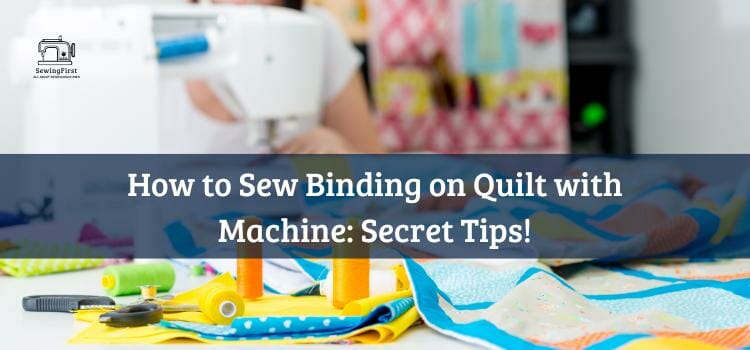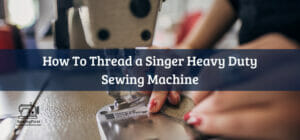Have you ever felt that the world is conspiring against your creative endeavors? Sewing binding on a quilt with a machine seems like an impossible task, but it doesn’t have to be. With some patience and practice, anybody can master this skill in no time! It’s almost as if fate has brought us here today to learn how to sew binding on a quilt with a machine.
We all want something cozy and comforting when we’re winding down at the end of the day; so why not treat ourselves to something special while learning one of life’s most rewarding skills – sewing binding on a quilt with a machine?
Not only will you gain valuable knowledge that you’ll use for years to come, but you’ll also create unique pieces of art that bring warmth and comfort into any space.
Are you ready to take the plunge and discover what it takes to become a true quilting expert? Here we show you step-by-step instructions on how to sew binding on quilt with machine so that even beginners can get started right away. Let’s begin our journey into the wonderful world of quilting!
Related Topic: How to Make a Quilt Without a Sewing Machine: No Machine? No Problem!
Table of Contents
ToggleWhat is Quilt Binding?
Quilt binding, also known as bias binding, is the final step in finishing a quilt. It’s a frame of fabric that wraps around the raw edges to give it a finished look and feel. This can be done by hand or with a machine. Depending on how you want your quilt to look, there are many types of bindings available — from wide bindings to narrow ones — so choose carefully!
First off, when machine-binding your quilt, make sure you have the right materials: fabric for the binding fold, iron-on adhesive tape (if using pre-folded bias binding), measuring tape/ruler, and sewing thread. Begin by determining what type of binding you’d like — single-fold or double-fold – then cut strips of fabric accordingly.
If using pre-cut fabrics, join them together following the manufacturer’s instructions. Now you’re ready to attach the binding fold onto your quilt edge with either pins or an iron-on adhesive tape before starting to sew it on.
Once everything is set up correctly, start sewing from one corner and gradually move along the entire perimeter of your quilt until all four sides are complete. Finally, finish off with some neat stitches and clips for extra security before admiring your work!
With these steps in mind, you’ll be able to create beautiful finishes every time – no matter if it’s single-, double-, or even triple-fold binding!
Double-Fold Vs Single-Fold Quilt Binding
When it comes to quilting binding, there are two primary types: double-fold and single-fold. Knowing the pros and cons of each is important when selecting which type you want for your baby quilt or other projects.
Double-fold binding has a mitered fold at the corner that creates a finished look on any quilt edge. To sew this type of binding with a machine, you’ll need to use either a zipper foot or straight stitch presser foot and work from one side of the fabric piece to the other. This method may take some time but results in a professional finish.
Single-fold binding can be sewn quickly but doesn’t always provide as polished an appearance as double-fold does. The process involves folding over the edges using an iron before sewing with a regular presser foot along both sides; all without having to worry about mitering corners!
However, since only one layer of fabric covers the raw edges, single-fold tends to wear out faster than double-fold binding.
So if you’re looking for something with longevity and strength – especially when making items like baby blankets – then double-fold might be worth considering. Ultimately, it’s up to you how much effort you’d like to put into creating your final product.
How To Calculate Quilt Binding Length
Quilting is one of the most rewarding hobbies out there. It combines two activities that many people find calming and satisfying: sewing and creating a beautiful finished product. Calculating quilt binding length may sound intimidating, but it’s actually quite simple with the right guidance.
To work out your quilt binding length, you’ll need to figure out the perimeter of your quilt pattern first. Measure from side to side along each edge, then add up all the measurements for an accurate total measurement.
Once you know this number, you can start calculating how much fabric you’ll need for binding. To get started, measure a diagonal seam on one corner of your quilt using a ruler or tape measure; make sure to include any extra seam allowance in this calculation too!
Then multiply this number by four so that you have enough material to bind all four corners of your quilt – don’t forget to factor in some extra inches if necessary.
When picking thread color for binding your quilt, opt for something neutral like white or cream as these colors will blend into most fabrics well without detracting from its overall beauty.
When stitching together the binding strips, use a narrow zigzag stitch with matching thread and adjust the tension settings carefully so that the stitches stay neat and secure while avoiding puckering around curves and sharp angles. Taking care when completing these steps can ensure you create a professional finish every time!
By following these tips on measuring and selecting materials correctly, you’ll be able to craft stunning handmade quilts quickly and easily – no matter what size or shape they are!
How To Work Out Yardage Requirements & Number Of Strips To Cut
Figuring out the yardage requirements and the number of strips to cut for quilt binding is an important step in any quilting project. Let’s take a look at how this is done!
To start, you’ll need to decide on your raw edge width. Then use a rotary cutter to cut fabric strips that are twice as wide as the desired finished size of your binding. Your strips should be cut at a 90-degree angle from the selvage edge of the fabric.
Here are some top tips to keep in mind when preparing quilt bindings:
- Measure each strip with precision using a ruler or other measuring device before cutting it with the rotary cutter
- Make sure all strips are cut at a precise 90-degree angle so they will fit together properly
- Consider investing in specialized tools such as bias tape makers if you plan to make multiple projects requiring quilt binding
- Read through our comprehensive quilt tutorial to learn more about this process!
Now that you know what supplies and techniques are required for making accurate cuts, we can move on to another key question: do you sew the binding on the front or back of a quilt?
Do You Sew The Binding On The Front Or Back Of A Quilt?
Did you know that quilting is one of the fastest-growing hobbies in America? Sewing bindings on a quilt can be an enjoyable and creative experience if done correctly with the right tools. Here are three tips to help you create beautiful binding for your quilt by machine:
- Make sure your sewing machine is threaded properly, using both top thread and bobbin thread.
- Use mitered corners when folding over the edges of the binding to maintain neatness and give the quilt a finished look.
- Utilize decorative stitches to add extra flair – this will make your project really stand out!
Applying binding to a quilt requires some skill and patience but it’s worth it for the stunning results. It’s important to decide whether you want to sew the binding on the front or back side of the quilt before beginning; most people prefer sewing them onto the back since they can use their favorite decorative stitch without worrying about visibility from the front.
However, some like to have it shown on both sides so they can enjoy its beauty no matter which way they turn their quilt. Whatever decision you choose, just remember to take time with each step as sewing machines aren’t always forgiving when mistakes happen!
How to Sew Binding on Quilt with Machine: Helpful Tools
Binding your quilt is an important step in creating a finished look. But it can be intimidating to sew the binding on with a machine. Luckily, there are some helpful tools that make the process much easier!
First off, you should watch a few video tutorials or read up on quilting tutorials. This will help familiarize you with how to properly use your sewing machine and its features for this specific task of sewing binding onto a quilt.
Make sure you have everything you need ready; feed dogs lowered, straight stitches set, and the right type of sewing needle inserted into the machine.
Some machines may require special settings so check out what works best for yours before getting started. When you feel comfortable with all these elements then start piecing together the fabric strips around your quilt edges – one stitch at a time!
With practice comes perfection and soon enough you’ll be able to create beautiful bindings quickly and easily by following simple steps like these. To ensure success when working on bigger projects, repeat these steps each time until they become second nature as well as make modifications along the way if needed.
Now that you’re equipped with some handy tips for setting up your machine for attaching binding let’s move onto which side to start on for machine quilt binding!
Which Side To Start On For Machine Quilt Binding
When it comes to sewing binding on a quilt with a machine, many people believe that the process is too complicated and time-consuming. But with the right tools at hand – like access to excess fabric strips and matching thread– this task can be surprisingly easy and straightforward.
One of the most important parts of using a machine for quilt binding is deciding which side to start on. To get started, you’ll want to use an original stitch along one edge of your quilt with a ¼ inch degree seam allowance.
Once done, cut off any excess fabric from the edges so they lay flat against each other once folded over and pinned down into place. Now you’re ready to begin sewing your binding onto the first side!
Sewing Your Binding On The 1st Side
The quilt is the finished product of all your hard work, as a patchwork puzzle pieced together with layers of fabric. Taking binding on to seal the edges and create that mitered edge gives you one last thing to master before your project can be completed.
Sewing your binding on the first side requires precision as you move corner to corner along those seam lines. To ensure a neat finish, it is important to take care when feeding the fabric through the machine.
TIP: Place pins between each fold for extra support while sewing if needed!
Focus on maintaining an even stitch length and tension throughout the entire process so that once complete, your quilt looks polished and professional. This is also where practice makes perfect – time spent practicing will pay off in accuracy and speed later down the line!
Join The Binding Ends Together
When it comes to quilting, the binding process is one of the most important steps. It’s what gives the quilt an aesthetic and finished look. But when it comes to joining your binding ends together, it can be tricky! You need a thicker fabric for durability and no loose threads in sight – otherwise, you may have to use a seam ripper to fix any mistakes made.
Luckily, by following a few simple steps, you can join your binding ends together with ease. Start by cutting two equal-sized pieces of your chosen material; this will help create uniformity in the overall look of your quilt’s border.
Then lay both strips right sides together at a 90-degree angle so that they form an ‘L’ shape and pin them securely in place. Sew along the diagonal line from corner to corner with a ¼ inch seam allowance making sure all edges are aligned correctly – this will create one long piece after ironing open the seams.
The last step is where we bring these two pieces together for our final result: take the short end of each strip and overlap them by about 1/4th inch before sewing across their width with approximately ½ inch seam allowance on either side (careful not to stretch out any fabric).
This overlapping method allows us to create sturdy joins between our two pieces without having excess bulkiness as part of our quilting process – now you’re ready to start basting your binding onto the back of your quilt!
Baste Your Binding To The Back Of The Quilt
It’s almost time to sew your binding onto the quilt – but before you do, there’s one more step that can make a huge difference. It may not seem like much, but basting your binding to the back of the quilt is an important part of this process. Here are three things to keep in mind when doing so:
- Take your time – rushing never helps!
- This will help ensure your binding stays put while stitching it down.
- If done correctly, it should take less than ten minutes.
So let’s get started! To begin, lay out the quilt with its wrong side facing up on a flat surface and smooth it out until it lies evenly over the entire piece. Then position the binding along the edge of the quilt as desired and pin or clip in place if necessary.
Now that everything’s in place, stitch across all layers using a small zigzag stitch about 1/4 inch away from the edges for added security and stability. This technique creates what is known as a “basted seam” and provides just enough hold without adding extra bulkiness to your project.
With this step complete, you’re almost ready to start sewing down your binding! All that remains now is preparing for stitching by threading your machine properly and ensuring both fabric pieces are lying smoothly underneath it.
Preparing To Stitch The Binding Down
As the old saying goes, “Practice makes perfect!” and that couldn’t be more true when it comes to sewing binding on a quilt. It’s important to get the steps right before you begin stitching down your binding–so let’s take a look at how to properly prepare for this task.
First off, make sure your basting is done correctly. This step will ensure that your binding lays flat against the back of the quilt while being sewn in place. With everything securely basted, now is the time to thread up your machine with the appropriate color of thread and select any needed settings such as stitch length or tension.
Next, attach a walking foot attachment (if equipped) or an even feed foot onto your machine to help guide the fabric through evenly along with preventing puckering.
Additionally, press out any wrinkles on both sides of the binding so they lay smooth prior to starting stitching them down by folding each side over once and pressing again if desired. By following these simple preparatory steps beforehand, you can create beautiful bindings for all your quilts!
How To Miter Corners
Preparing to miter the corners of your quilt can be daunting, especially if you’re new to sewing. But with a few simple steps, you can create beautiful results like an experienced seamstress! Here are four tips for success:
- Always use pins when joining binding strips in order to keep them securely together;
- If you have trouble matching up the edges accurately, consider using fusible webbing or spray basting for extra precision;
- Use either steam-a-seam tape or heat-activated glue stick on the wrong side of the quilt corner and press it down before folding over the miters;
- Take your time as accuracy is key here – practice makes perfect!
Now that we have our mitered corners ready to go, let’s move on to securing them in place. There are several different methods and techniques depending on what type of look you want.
We will take a closer look at these options next. Thanks to some preparation and patience, we now have all the tools needed to finish off our quilt with professional-looking mitered bindings. Onward and upward!
Stitching Down The Binding
Now that you’ve prepared the corner binders, it’s time to stitch them down. This is a relatively straightforward process, but there are some tips and tricks which will make your quilt look perfect! Let’s get started.
First, position the binding on the edge of the quilt so that one-half inch extends beyond. Then, using an appropriate needle size for your fabric type, start stitching just inside the fold line at a slow speed.
When you reach a corner miter, stop with the needle in the down position and rotate your quilt 90 degrees before continuing sewing. Repeat this step until all four sides have been stitched down.
Another tip is to press as you go along – pressing can help keep everything neat and tidy while ensuring good accuracy in seams when attaching each side together. Plus, don’t forget to use pins or clips to secure edges if needed; this will help prevent any potential puckering from occurring during sewing.
By taking care throughout this part of the process, you’ll end up with cleanly finished corners and a beautiful overall finish on your quilt! Onward now to creating a perfect corner…
Creating A Perfect Corner
Creating a perfect corner is the key to making sure your quilt looks and feels finished. It can be intimidating at first, but with practice, you’ll soon find it’s quite easy!
When I started sewing binding on my quilts, getting the corners just right was always a struggle for me. But then one day an experienced quilter showed me her trick for creating that perfect mitered corner each time.
To create a perfectly mitered corner when sewing binding on a quilt:
- Start by cutting the edges of the binding fabric so they are 90-degree angles when placed against each other.
- Place one end of the binding along the edge of the quilt, wrong sides together, and stitch down in place using a 1/4 inch seam allowance.
- Stop stitching 3-4 inches before reaching the next corner and fold the fabric so it forms a 45-degree angle against the edge of the quilt (forming what looks like an upside-down ‘L’).
- Fold over again at another 45-degree angle, forming two layers of folded material; both should lay flat against each other with no gaps between them.
- Pin or clip in place and finish topstitching all around this new section until you reach where you stopped initially – make sure to backstitch several times at this point for extra durability.
These steps will ensure that once stitched into place, your mitered corner lays completely flush and creates an impeccable look to your quilt!
Not only do these sharp corners bring out more detail in your project, but they also provide greater protection from wear and tear due to their structure being kept secure throughout use. With some practice, you’ll be able to confidently sew any type of binding onto any size quilt quickly and easily!
Finish Sewing The Corner
Now that we’ve tackled that task, let’s take a look at what comes next: finishing up our sewing as we prepare for completion!
Before taking any further steps, make sure your fabric and thread are secure and ready to go. A great way to double-check everything before moving forward is by giving yourself a mini “safety” checklist of sorts – kind of like an airline pilot would do before takeoff!
Once all details have been verified, begin stitching along the edge of the binding until reaching the endpoint at the corner.
Slowly turn both layers of fabric so they’re aligned once again, then continue stitching around the other side in order to close off the corner completely. It’s also helpful to remove pins as you go; this will help prevent any potential snags while operating your machine.
As long as you keep things organized and tidy during each phase of construction, your finished product should be absolutely beautiful!
Now it’s time to sit back and admire your work – from start to finish, creating a perfectly sewn corner has never felt better!
Conclusion
The last step in completing a quilt is sewing the binding down. It can be tricky to get everything right and create that perfect corner, but with some practice, it becomes easier. Sewing the binding on your quilt is like weaving together all of the elements into one beautiful tapestry – you can take pride in knowing you created something special!
My advice? Just keep practicing and don’t be afraid to make mistakes; everyone does at first. Once you become comfortable with machine-stitching your bindings, you’ll find yourself making more and more beautiful quilts in no time!
FAQs
Can you machine sew binding on a quilt?
Yes, you can machine sew binding on a quilt. There are several methods that can be used to attach binding to a quilt, including using a straight stitch, a zigzag stitch, or a decorative stitch.
Do you machine quilt before binding?
Yes, machine quilting before the binding is a common practice in traditional quilting. It is done to secure the layers of the quilt together and create a finished look.
What stitch is best for quilt binding?
The most common binding stitch for quilting is the double-fold binding stitch. This stitch uses a continuous strip of fabric folded in half lengthwise, with the edges of the fabric tucked inside the folded raw edges. This stitch creates a strong, finished edge that looks great on any quilt.
What is the easiest quilt binding method?
The easiest quilt binding method is the single-fold binding technique. This technique involves folding over one edge of the quilt to the back, and then folding the backing fabric over the quilt edge and hand-stitching or machine-stitching the binding down. This technique is the easiest because it does not require any special tools and can be completed relatively quickly.





